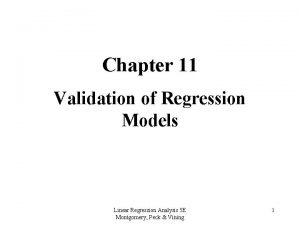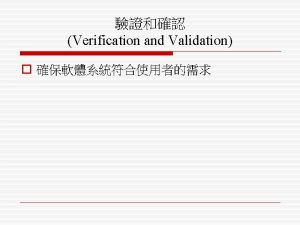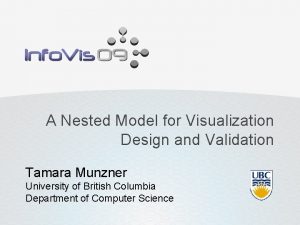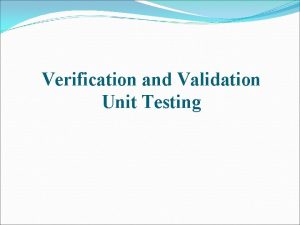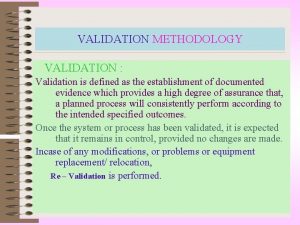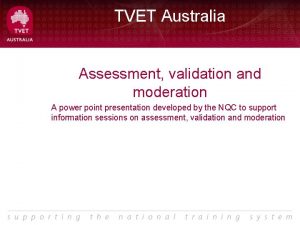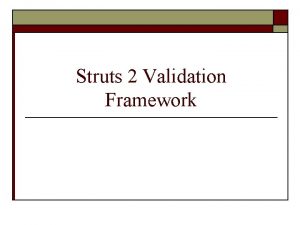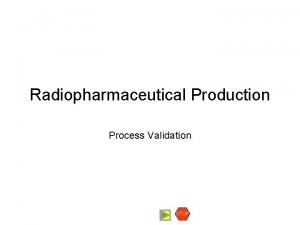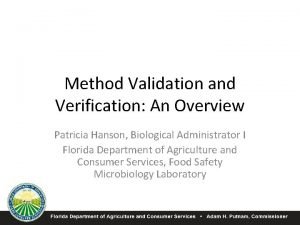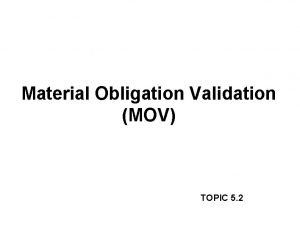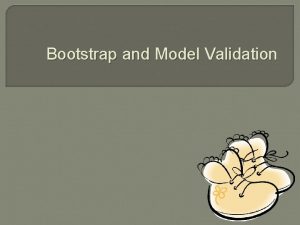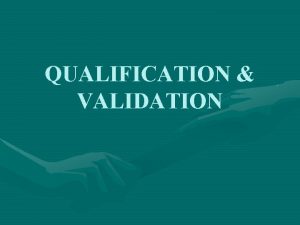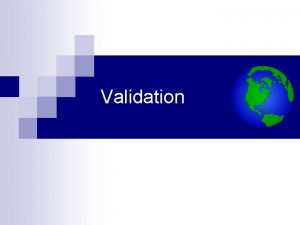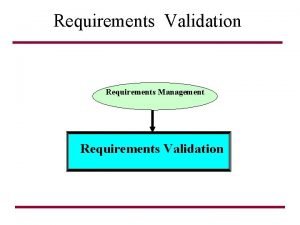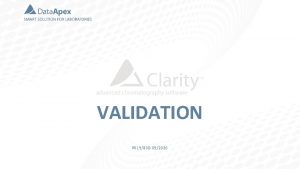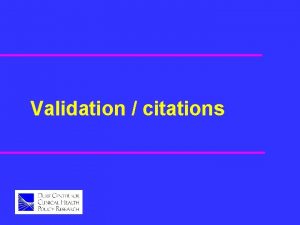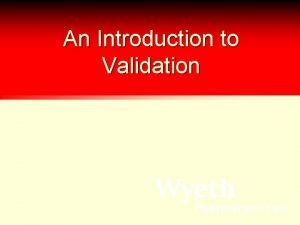8 Model Validation 1 Introduction Model validation is













![Now, let us try an OE model: m. OE = oe(id, [3, 3, 1]); Now, let us try an OE model: m. OE = oe(id, [3, 3, 1]);](https://slidetodoc.com/presentation_image_h/d9b6d836f253be6b39ef3f169f96f662/image-14.jpg)

- Slides: 15

(8) Model Validation 1

Introduction • Model validation is a crucial step to evaluate the quality of estimated models. • If validation is unsuccessful, previous steps in the system identification workflow must be redone – e. g. , the model structure can be changed. 2

Motivation • So far, we validated and selected models by examining plots of predicted vs. measured outputs. • In this section we will learn about additional statisticallybased validation tests, namely the correlation tests of the residual error. 3

Test (1): Whiteness of the residual error • Residual error is the difference between the measured output and the output predicted by the model: • Residual error represents the information in the measured output which can't be explained by the model. • For a good model, the residuals must be a set of random numbers caused by experimental errors. Any trend such as a gradual rise or a slight curve in the plot of the residuals invalidates the results. Ideally, residuals ε(k) should be zero -mean white noise. 4

Autocorrelation function of ε(k) • Given the residuals, an estimate of their autocorrelation function, • can be obtained as: 5

Autocorrelation function of ε(k) • If the residual ε(k) is purely random (zero-mean white noise), we should have • Note that the variance of the residuals is given by rε(0). • Define the normalized auto-correlation function as: • The condition x(τ) = 0 for τ≠ 0 almost never holds exactly for data taken from an actual experiment. Instead, the autocorrelation function usually exhibits small values for τ ≠ 0. 6

Testing the Whiteness of ε(k) • It can be shown, for large number of data points N, that x(τ) is distributed according to the following Gaussian distribution • Therefore, if • then we can assume, with 99% confidence, that x(τ) or rε(τ)=0, and we can conclude that the residuals are white. 7

Tests (2): Independence of the residuals on past inputs • If the model is accurate, it should entirely explains the influence of inputs u(k) on future outputs y(k+τ). • Therefore, future residual errors ε(k+τ) • should only be influenced by the disturbances, and be independent of past inputs u(k). 8

Cross-correlation of ε(k+τ) & u(k) • If ε(k+τ) are uncorrelated with past input u(k), the crosscorrelation should be zero for τ ≥ 0. • Estimation from data and normalization: 9

Independence test • Like before, for large N, x(τ) is distributed according to the following Gaussian distribution • Therefore if: then we can assume, with 99% confidence, that x(τ) or rεu(τ) = 0, and we can conclude that the future residuals are independent of past inputs. 10

Example Assume that the real system to be identified has an outputerror (OE) form of order 3: The identification and validation data are as shown: 11

First, we try to identify an ARX model: m. ARX = arx(id, [3, 3, 1]); resid(m. ARX, val); The model fails the whiteness test and, therefore, the model is rejected. This is because the system is not within the model class, leading to an inaccurate model. 12

Simulating the ARX model on the validation data confirms that the model is not so accurate. 13
![Now let us try an OE model m OE oeid 3 3 1 Now, let us try an OE model: m. OE = oe(id, [3, 3, 1]);](https://slidetodoc.com/presentation_image_h/d9b6d836f253be6b39ef3f169f96f662/image-14.jpg)
Now, let us try an OE model: m. OE = oe(id, [3, 3, 1]); resid(m. OE, val); As can be seen, the OE model passes the two tests and therefore should be accepted. The reason is that the OE model class contains the real system. 14

Simulating the OE model on the validation data confirms the good quality of the model. 15
 Linear regression model validation techniques
Linear regression model validation techniques V model verification and validation
V model verification and validation Pricing model validation
Pricing model validation A nested model for visualization design and validation
A nested model for visualization design and validation Asp.net request validation bypass
Asp.net request validation bypass Is unit testing verification or validation
Is unit testing verification or validation Wpf validation.errortemplate
Wpf validation.errortemplate Types of process validation
Types of process validation Validation and moderation templates
Validation and moderation templates Twic certified identification & verification management
Twic certified identification & verification management Struts2 workflow
Struts2 workflow Master validation plan
Master validation plan Xbrl tutorial
Xbrl tutorial Method verification vs validation
Method verification vs validation Method verification vs validation
Method verification vs validation Material obligation validation
Material obligation validation
